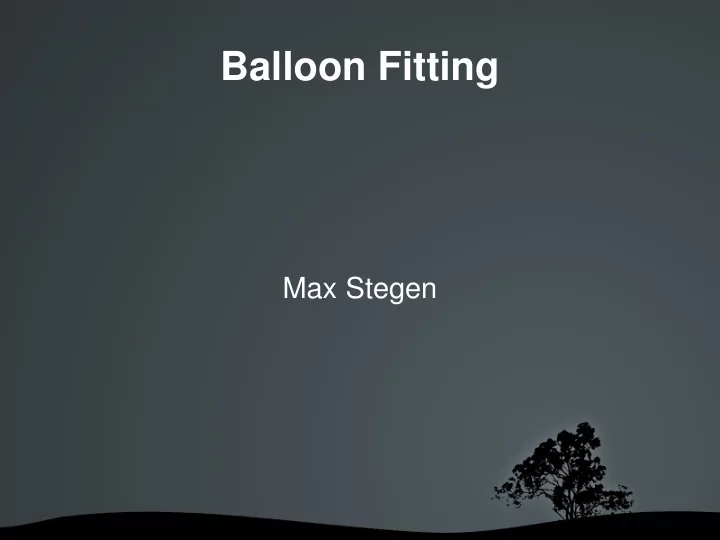

Balloon Fitting Max Stegen
Content Introduction Movement Subdivision Algorithm Holes & Noise Conclusion & Test Results Balloon Fitting - Max Stegen 2
Content Introduction Movement Subdivision Algorithm Holes & Noise Conclusion & Test Results Balloon Fitting - Max Stegen 3
Introduction reconstruction with adapting mesh start: Icosahedron points connected with springs points moved with forces move points until they reach the objects surface Balloon Fitting - Max Stegen 4
Introduction - Example Balloon Fitting - Max Stegen 5
Content Introduction Movement Subdivision Algorithm Holes & Noise Conclusion & Test Results Balloon Fitting - Max Stegen 6
Motion Equation m i ¨ x i r i ˙ x i g i = f i , i = 1...N x i :position of element i ˙ x i :1. derivative of x with respect to time x i :2. derivative of x with respect to time ¨ m i :mass of element i r i :damping coefficient g i :sum of forces from neighboured elements f i :external force Balloon Fitting - Max Stegen 7
Simplification m i = 0 r i = 1 x i = f i − g i , i = 1...N ˙ Balloon Fitting - Max Stegen 8
Springforce s ij = c ij e ij ∥ r ij ∥ r ij c ij :stiffness of the spring e ij =∥ r ij ∥− l ij :deformation r ij = x j − x i l ij :natural length of the spring N s ij g i = ∑ j = 1 Balloon Fitting - Max Stegen 9
Inflation Force h i = k n i h i :inflation force k :amplitude of the force n i :direction normal to the local model surface n ij n ' ij n i , n i = ∑ n i = ∥ n i ∥ ∥ n ij n ' ij ∥ Balloon Fitting - Max Stegen 10
Content Introduction Movement Subdivision Algorithm Holes & Noise Conclusion & Test Results Balloon Fitting - Max Stegen 11
Subdivision triangles are growing tension increases stops the growing process solition: subdivide triangles more triangles more accurate tension decreases Balloon Fitting - Max Stegen 12
Subdivision (2) just divide triangles on the front no degenerate triangles find triangles to subdivide divide triangles on longest edge divide neighboured triangles Balloon Fitting - Max Stegen 13
Subdivision - Algorithm tf0 : set of triangles in a given front t0 : set of triangles to subdivide 1. for each T in t0 bisect T on the longest edge 2. find R1 (set of non-conforming Triangles from Step 1) k <- 1 3. for each T in Rk P <- non-comforming Point in T bisect T on the longest edge if P not on longest edge join P with longest edge 4. find Rk+1 (set of non-conforming Triangles from Step 3) 5. if Rk+1 = {0} then stop else k <- k + 1 go to step 3 Balloon Fitting - Max Stegen 14
Problems only triangles in the front are divided degenerate triangles are produced Balloon Fitting - Max Stegen 15
Content Introduction Movement Subdivision Algorithm Holes & Noise Conclusion & Test Results Balloon Fitting - Max Stegen 16
Algorithm chose a good point to start place the icosahedron put all triangles in front F0 push front F0 into queue Q until Q is empty do following algorithm Balloon Fitting - Max Stegen 17
Algorithm (2) 1. F <= top of the queue Q, pop Q 2. subdivide triangles if appropriate v i 3. for each vertex in F a. compute forces and = g i f i h i t t b. compute new location v i c. <- prospective cossespondence point of w i v i ∣ v i t ∥ ∥ w i − v i t ∣ t t − v i d. if t t ⇐ w i v i mark as anchored v i 4. for each vertex in F v i t ⇐ v i t t v i 5. discard anchored triangles from F 6. if F = {0} go to 1 7. recompute conntected triangle regions in F and push them into Q go to 1 Balloon Fitting - Max Stegen 18
Content Introduction Movement Subdivision Algorithm Holes & Noise Conclusion & Test Results Balloon Fitting - Max Stegen 19
Holes & Noise holes: no correspondence point for whole front set inflation force = 0 (k = 0) front reaches equilibrium state interpolation over the hole noise: errors in the object often dealt with by line-surface intersection algorithm good possibilities to filter things out Balloon Fitting - Max Stegen 20
Content Introduction Movement Subdivision Algorithm Holes & Noise Conclusion & Test Results Balloon Fitting - Max Stegen 21
Conclusion object reconstructed by inflating balloon model growing simulated by physical forces triangles subdivided to keep mesh growing good handling of holes and noise Balloon Fitting - Max Stegen 22
Test Results Sun Sparc-10, Lucid Common Lisp v. 4.0 2850 vertices 1694 vertices 5696 triangles 3384 triangles 32m, 26s 16m, 17s Balloon Fitting - Max Stegen 23
Reference Yang Chen, Gerard Medioni : 2 Description of Complex Objects from Multiple Range Images Using an Inflating Balloon Model Balloon Fitting - Max Stegen 24
Recommend
More recommend